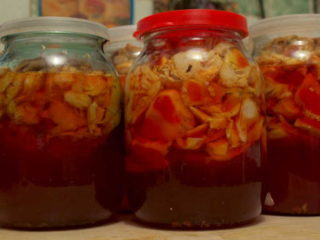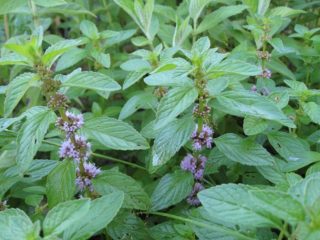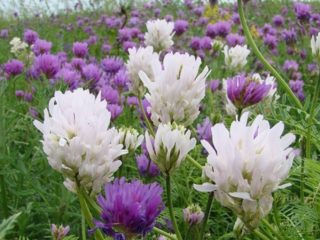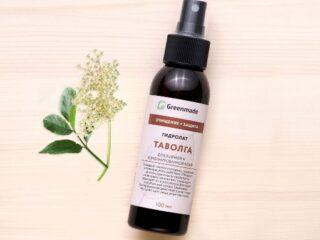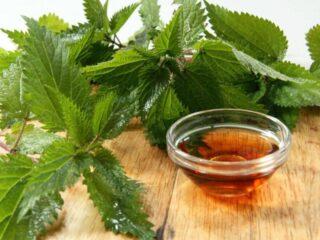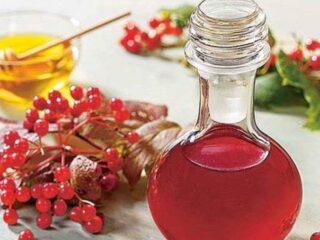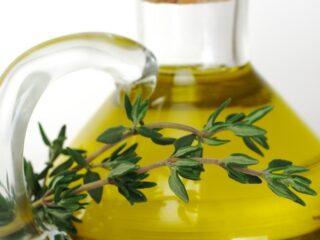Content
Castor bean attracts gardeners due to its highly decorative appearance. The plant has large, cut-out leaves of an unusual purple-green color. Another quality that makes castor beans popular is their ultra-fast growth.
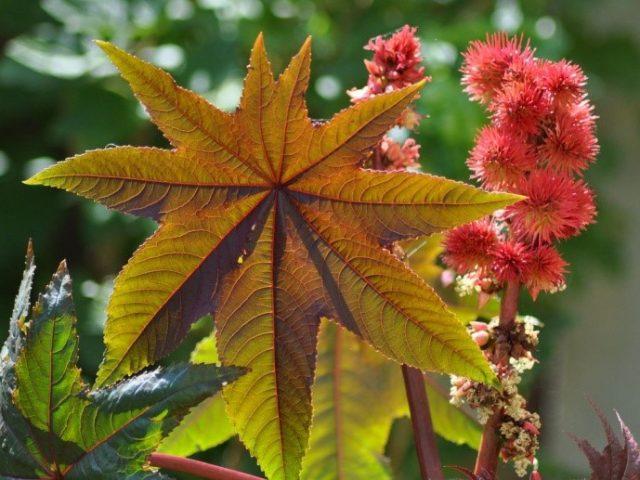
Castor beans are afraid of cold and cannot tolerate temperature drops to 0°C; at the first frost, the plant dies
What is castor oil used for?
Many gardeners believe that information about the toxicity of castor beans is greatly exaggerated. And they cultivate a dangerous plant in personal gardens and city squares. Experts in the field of botany and medicine will help you decide whether castor beans are harmful or beneficial.
Using castor beans in the garden
Debates about the benefits and harms of castor beans and the possibility of growing the plant in gardens and recreational areas have been going on for decades. First of all, the issue is relevant for owners of personal plots.
In fact, castor beans look quite impressive. The stems of the plant in a temperate climate zone grow up to 2-3 m. Graceful dissected leaves reach half a meter in diameter.Due to the fact that the leaf blades extend from strong petioles, the plant looks like a fan palm. Small flowers form beautiful inflorescences in the form of brushes, standing out noticeably against the background of foliage. Enthusiasts plant poisonous castor beans without thinking about the consequences.
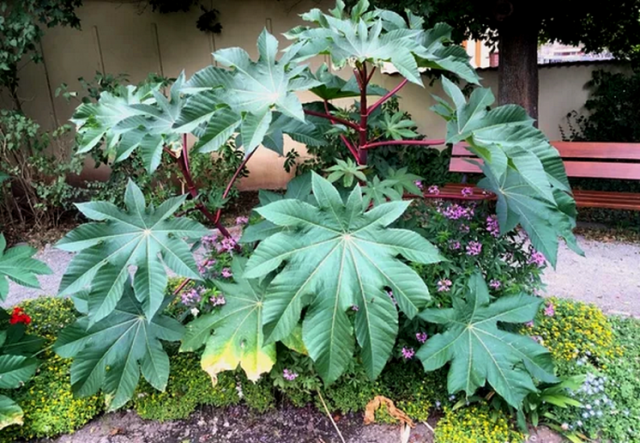
Annual castor bean bushes are found in Russia; the plant acts as a beautiful, but dangerous element of landscape design
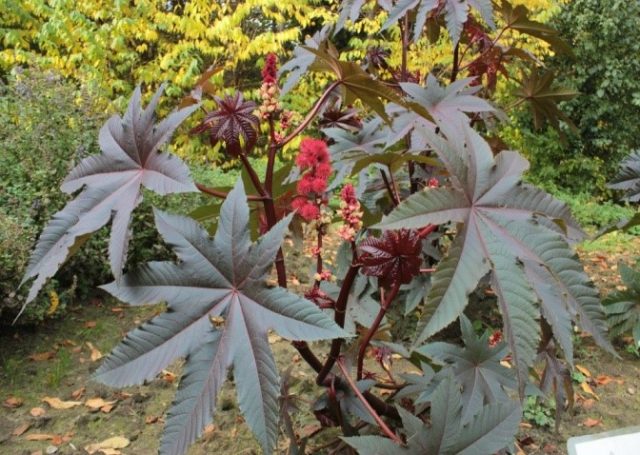
After sowing, seedlings appear a few weeks later, young castor bean sprouts develop in an extremely short time
The use of castor beans in medicine
This dangerous plant also has beneficial properties, which is why castor oils are used in medicine. Since ancient times, castor oil has been obtained from the seeds of a poisonous plant by cold pressing, containing substances that stimulate muscle contraction and have a pronounced laxative effect.
The drug is used in the medical field:
- in obstetrics to ease contractions in the process of assisting during obstetrics;
- in the form of a laxative for disorders of the digestive tract and for cleansing the intestines;
- as a component of balsamic liniments and ointments intended for antiseptic treatment and acceleration of tissue regeneration;
- in dermatology and trichology as an ingredient in ointments and balms for restoring thinning hair, improving hair growth and restoring nail plates.
In recent years, castor oil has been used in massage treatments. The product is used in wraps for anti-cellulite massage.
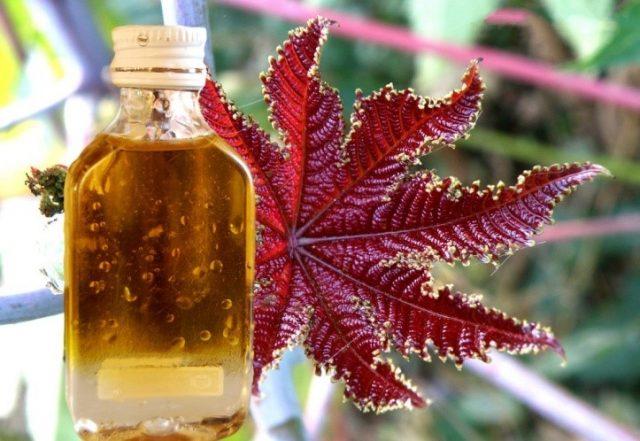
Castor oil is widely used in home medicine as a skin, nail and hair care product.
Which part of the castor bean is poisonous?
All parts of castor beans are poisonous to a greater or lesser extent. During flowering, dangerous ricinin mainly accumulates in the flowers of the plant. Toxins are concentrated in the greatest quantities in fruits. Castor bean seeds are visually attractive, but the alkaloid ricinin they contain is classified as a powerful toxin. It is more poisonous than potassium cyanide, cobra venom and the chemical warfare agent sarin.
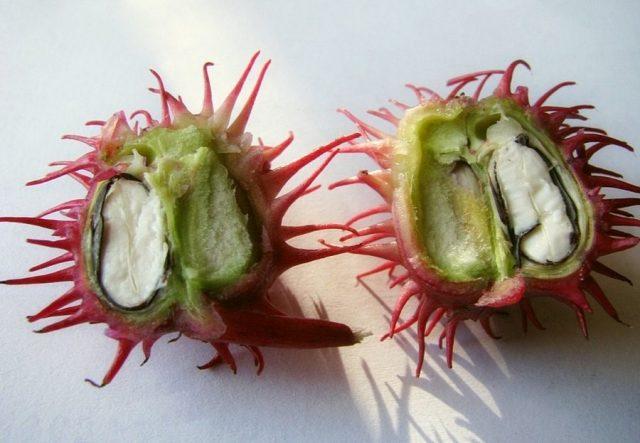
The name “castor bean” was given to the shape of the seed pods; divided into halves, they resemble ticks that have drunk blood
What happens if you eat castor bean seeds?
Although castor bean seeds do not have a good taste, curious children and teenagers often try the enticingly beautiful beans. The seed shells contain a huge amount of poison. A dangerous tasting can result in death. Death in a child is caused by 2-3 eaten poisonous fruits, and in adults - 8-10 seeds.
Poisoning by castor bean seeds
Unfortunately, there are quite a lot of cases where a child or several children have been poisoned by castor beans. Most often, children eat life-threatening beans while walking unaccompanied by adults.After all, poisonous plants similar to tropical palm trees everywhere decorate front gardens near residential buildings, roadside alleys in boarding houses and parks.
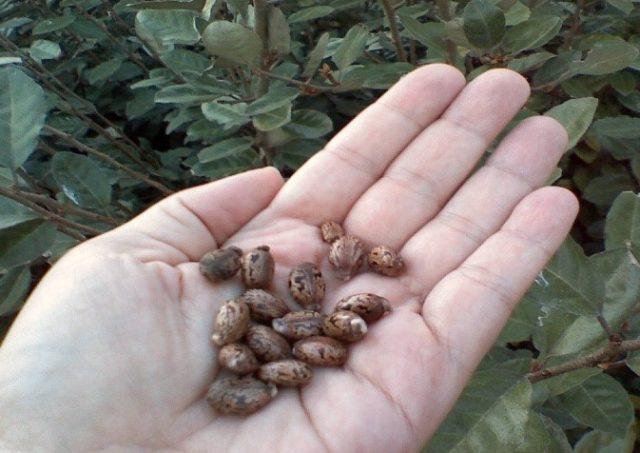
A particular health hazard is posed by the kernels of castor bean seeds, which are 17% composed of toxic protein compounds ricin and ricinin.
Symptoms of castor bean poisoning
The greatest danger of castor beans is that signs of poisoning do not appear immediately. The first dangerous symptoms may appear several hours or even a day after poisonous beans have been eaten. The symptoms are similar to those characteristic of food poisoning. When castor bean seeds enter the gastrointestinal tract, the following symptoms appear:
- nausea and profuse bloody vomiting;
- cutting pain in the abdomen;
- diarrhea mixed with blood;
- general weakness, drowsiness, apathy;
- lowering blood pressure,
- hyperthermia;
- dry mouth;
- convulsions;
- decreased hearing and vision, up to complete loss.
The dangerous poison contained in castor beans provokes the gluing of red blood cells and, as a result, poor circulation. The resulting blood clots lead to life-threatening hemorrhages and erosions on the mucous membranes of the stomach and intestines. A victim of a poisonous plant may develop paralysis.
Often a child cannot remember that he ate castor beans. If difficult, the cause of poisoning can be determined by urine analysis. The presence of protein and red blood cells indicates a dangerous destruction of the kidney vessels for the body.In severe cases, bleeding occurs in the stomach, lungs or brain. Violation of the water-electrolyte balance and irreversible changes in the internal organs lead to the fact that a few days after poisoning with the poisonous seeds of the plant, a person, especially if it is a child, dies.
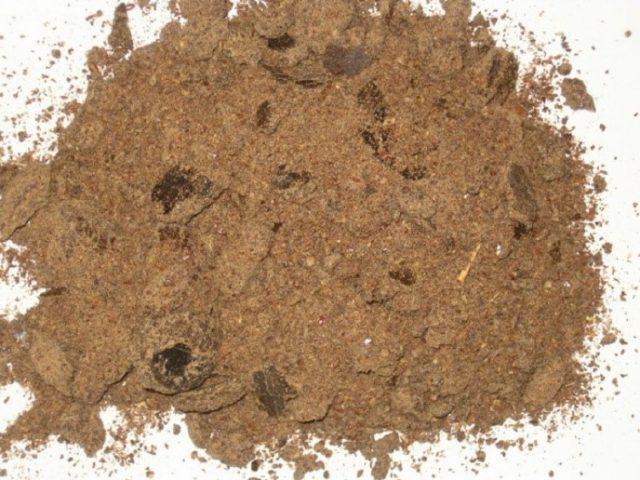
If poisonous dust from the plant is inhaled during processing of the cake, poisoning may occur.
First aid for poisoning
Based on the fact that the initial symptoms of intoxication are similar to food poisoning, first aid is provided according to a similar scheme. The main measures when poisonous castor bean seeds enter the digestive system are as follows:
- Call an ambulance.
- Gastric lavage using a special probe. If a medical device is not available, vomiting must be artificially induced.
- Taking enterosorbents (activated carbon, Enterosgel).
- In parallel with gastric lavage, cleansing enemas are given.
- To prevent kidney dysfunction, the victim is given sodium bicarbonate.
- In order to slow down the absorption of the poison, the patient is recommended to use an enveloping agent, for example, Almagel. In the absence of medications, it is permissible to eat a raw egg or drink jelly.
Be sure to rinse your mouth, nasopharynx, and eyes with sodium bicarbonate or water. In this way, the local effect of ricin can be reduced.
Treatment
A patient who is poisoned by poisonous seeds of a plant is prescribed bed rest. Due to the lack of an antidote (antidote), subsequent therapeutic assistance is aimed at cleansing the blood and overcoming dangerous manifestations. The set of procedures includes:
- blood transfusion;
- administration of powerful painkillers;
- taking diuretics to enhance the function of the urinary system;
- oxygen treatment.
It is important that the victim is under close medical supervision at all times. If help is promptly provided, the patient survives. But due to the destruction of protein structures in the child’s body by poisonous ricin, it is never possible to completely restore health. Medicine is powerless in this case.
Precautionary measures
There is no doubt how dangerous the castor bean plant is. The toxic properties of the shrub, and especially its seeds, should be taken into account when designing the landscape. The optimal solution is not to plant a dangerous plant in local areas or near social institutions. It is necessary to warn children about the threat to health and life posed by plant beans, and tell them in detail about the consequences of seed poisoning.
After any interaction with a poisonous crop, you should wash your hands thoroughly with soap. There is no doubt that the best prevention of poisoning is to avoid contact with a dangerous plant.
Conclusion
Castor bean is a potentially dangerous plant for people and animals. Severe poisoning of children has become more frequent, and it is rarely possible to save a child after he has tasted poisonous seeds, even if first aid is provided in a timely manner. It is necessary to listen to the opinion of doctors and not to plant a beautiful plant, but dangerous to the health of children, in populated areas.
